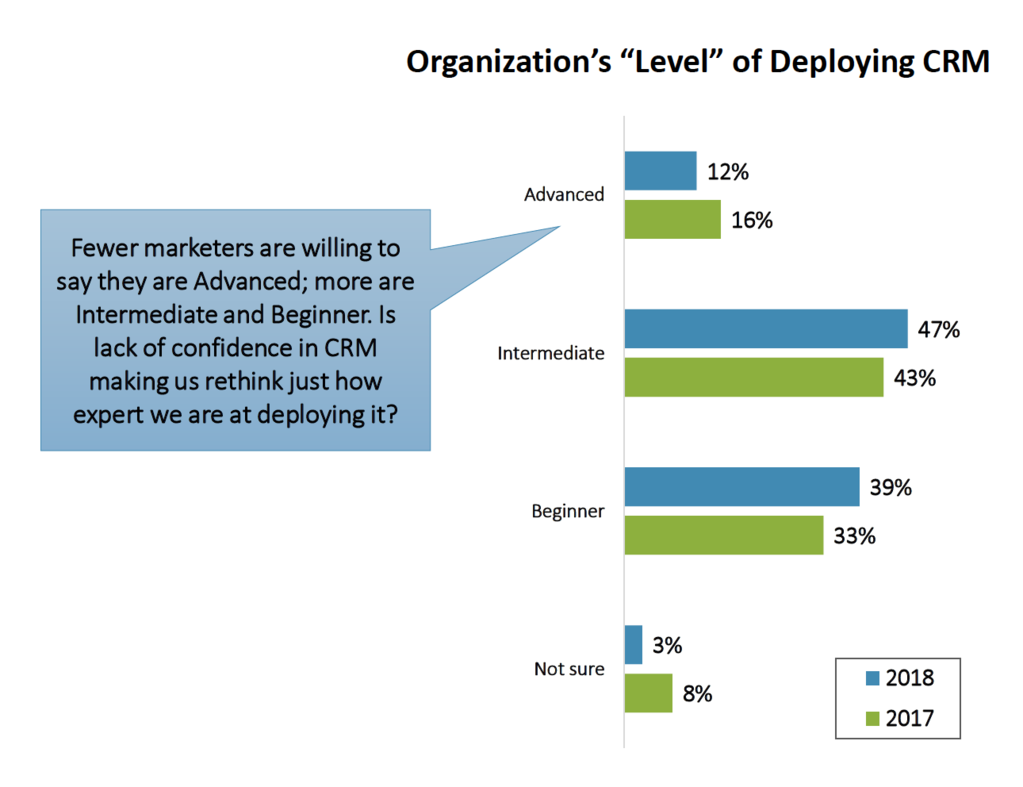Survey Highlights Healthcare Digital Marketing’s Growth, Challenges
// By Jared Johnson //
 Digital marketing in healthcare is in the midst of an evolution, with some revealing trends, including a mixed view of customer relationship management (CRM) and emerging technologies, according to the 4th Annual State of Digital Marketing for Hospitals report.
Digital marketing in healthcare is in the midst of an evolution, with some revealing trends, including a mixed view of customer relationship management (CRM) and emerging technologies, according to the 4th Annual State of Digital Marketing for Hospitals report.
The report, administered by Greystone.Net and Klein & Partners, highlights responses compiled from more than 200 healthcare marketing and digital professionals who completed the annual survey in the second half of 2018. The responses provide valuable insights for CEOs, CMOs, web and digital managers, and others involved in setting the current and future state of healthcare marketing.

Michael Schneider, executive vice president and co-founder, Greystone.Net
“I always find this study so interesting because it gives us a snapshot perspective of what is happening with digital marketing in the hospital and healthcare system vertical,” said Mike Schneider, partner at Greystone.Net. “It’s like we take an industry selfie every year and we get the opportunity to look back at what has changed year to year.”
Key Takeaways
Two of the things that changed significantly in 2018 were mobile website growth and lack of confidence in CRM usage, according to Schneider.
“There were so many interesting findings this year, but if I had to zero in on just a few, the first was seeing our industry hit that convergence point where mobile website traffic has exceeded desktop traffic,” Schneider points out. “For many organizations, this may have already happened, but for our niche market as a whole, we are finally there, and this has big implications for how we address a predominantly mobile world.”
In the survey, participants rated their confidence in their own organizations’ efforts in a number of different facets of digital marketing. This figure is referred to as the “Healthcare Marketing Confidence Grade.”
“We saw that marketers continue to show greater confidence in their website, social media, and digital marketing abilities, but their confidence in CRM continues to fall,” Schneider says. “I think this is indicative of the complexity of CRM and the ability for an organization to address internal expectations related to timing and implementation. I think we will see CRM confidence improve as organizations start to get their data straight and properly educate senior leadership about timing. But for now, it’s pretty clear that marketers are feeling less confident about their CRM efforts.”

Few organizations rank themselves as advanced practitioners of CRM in 2018.
The Evolving Digital Footprint
Among the report’s findings was an acknowledgment that the term “digital marketing” covers a lot of territory and includes an ever-growing number of strategies and tactics. Some of the more significant figures included the following:
- More than two-thirds of marketers use social media marketing, online advertising, paid search, email marketing, e-Newsletters, content marketing, and blogs.
- Nearly 60 percent have a CRM system, 42 percent have a marketing automation system, and 30 percent use a PRM system.
- More than 80 percent of hospital websites are designed responsively for mobile.
- Nearly 50 percent offer a mobile app for consumers.
As far as what will have the greatest impact on hospital and health system marketers, Schneider pointed to the growing breadth of the digital marketing footprint and the need to keep senior leadership up to speed.
“If you look at the array of what we say constitutes digital marketing, the greatest areas of growth were seen in social media marketing, online advertising, paid search, retargeting, and content marketing,” Schneider said. “I think those will continue to be growth areas and really emphasize how the breadth of the digital marketing footprint just continues to grow.
“We also saw growth in techniques like geofencing, and we saw new things like voice search showing up on the list. So I would say we’re getting our heads around the idea that our industry continues to evolve and that we have to be nimble and multi-tooled to be competitive with our peers. Digital marketing is not just the website. We probably still have a long way to go to keep our senior leaders up to speed on what digital marketing even is.”
Surprising Trends
The report’s organizers have learned that they can never predict all of the outcomes, despite several trends that have continued since the survey was first administered in 2015.
Kathy Divis, president of Greystone.Net, pointed to a lack of progress in measurement and analytics.

Kathy Divis, president and co-founder, Greystone.Net
“One rather depressing finding was that even after all these years, we, as healthcare marketers, are still mainly measuring passive metrics or, at best, leading indicators and not real results or real conversions, Divis said. “Frankly, I thought we’d be further along by now. We still have a long way to go.”
Schneider pointed out how few organizations use CRM for population health — just 25 percent, a higher figure than last year but still low when considering the many logical uses for CRM in this capacity and the local and regional focus on improving the health of populations.
“I also laughed out loud when we asked about new and emerging functionality on the website and the top two answers were Online Class/Event Registration and Online Bill Pay,” Schneider said. “These are two things we have been wrestling with for over a dozen years. But I think the evolution of the vendors and technology in this space, and the ability for organizations to get their data in order and break down barriers, has created a resurgence. The focus on both EMR and CRM has definitely created a cascading impact on these tools.”
All in all, the organizers indicated that the report’s findings are great news for all of us.
“Healthcare is catching up with other industries and finding new and creative ways to leverage digital marketing and demonstrate results,” Schneider said. “This shows the immense opportunity for marketers. The data also shows the opportunity for vendors — these slides show the churn in vendors for CRM, CMS, and other digital marketing — so the market continues to be ripe for opportunity. And we see that over three-fourths of budgets are expected to either stay neutral or grow in the coming year.”
The survey’s next installment will go out in October, and results are expected to be available in the first quarter of 2020.
Jared Johnson is a member of the eHealthcare Strategy & Trends Editorial Advisory Board. He is a healthcare consumer strategy advisor on a mission to make healthcare easier for everyday people. Wherever organizations are on their consumer journey, he serves as a valuable partner to help them operationalize consumer-first care through masterminds, workshops, and strategy consulting. He has produced hundreds of podcast episodes and thousands of articles, social media posts, and pages of web content as a senior digital strategist for some of the top healthcare and medtech brands in the country, including St. Jude Medical, Pfizer, W. L. Gore, and Phoenix Children’s Hospital.
Jared is a rapping keynote speaker, host of the long-running Healthcare Rap Podcast, founder of the Consumer-First Health Group, winner of the Medigy HITMC 2021 Marketer of the Year Award, and author of two books, Marketing Forward and Connect the Docs. When he isn’t challenging the status quo, he can be found running obstacle course races or hiking with his wife and their four children. Email him at jared@ulteradigital.com.

